Behaviors Uncovered: Leadership, Communication, Conflict Management and Team Contribution
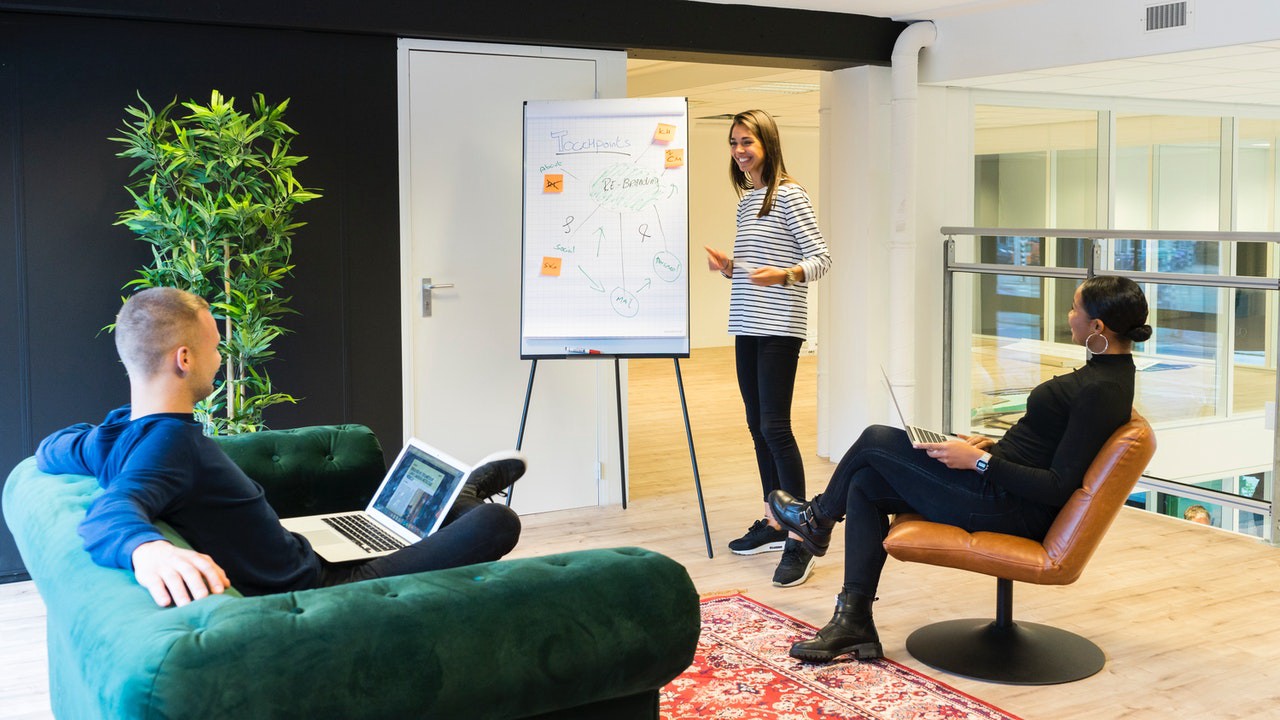
How can employers understand how someone will behave in a professional context? Do organizations have to rely on a trial-and-error approach to hiring and management, or is there a way to make better informed decisions based on science?
Thankfully, years of behavioral modeling have left a strong legacy in various fields of psychological research, from social psychology to behavioral economics. Using the progress in this area as a knowledge base, we were able to combine two key areas of results from our MyPrint® questionnaire — personality and motivational traits — to uncover the likely behaviors of individuals in professional settings.
From Personality and Motivations to Behaviors
MyPrint reports consist of three main areas of focus: Personality, Motivations and Behaviors:
- Personality traits correspond to the attitudinal & emotional characteristics underlying people’s stable behaviors.
- Motivations correspond to the desires and needs triggering, orienting and maintaining an individual’s behaviors towards a given objective.
- Behaviors represent the ranges of observable actions made by individuals in conjunction with their environment.
The 11 behavioral dimensions of MyPrint are displayed as score matrices resulting from the combination of personality and motivation dimensions of the assessment. Therefore, the behavioral styles of MyPrint are predicted based on the scores (high or low) that an individual has obtained on the personality and motivation dimensions crossed together. In short, these analytical grids give insights for understanding why an individual tends to foster a particular pattern of actions and how they maintain it.
As we uncover the science behind predicting behaviors in the workplace, we begin with four key dimensions for employers focusing on better understanding group dynamics within their teams: Leadership Style, Communication Style, Conflict Management and Team Contribution.
Leadership Style
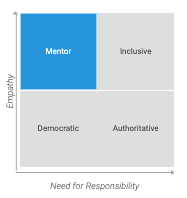
Leadership Style can be described as the way that a person motivates their peers to contribute to the effectiveness of their organization. This applies to individuals formal leadership positions, information leadership positions, or people who might not appear to have any leadership roles at all. Anyone can influence their peers and impact their organization.
There are four styles of leadership, derived from the combination of the “Empathy” dimension of personality and the “Need for Responsibility” dimension of motivation:
- Mentor (Empathetic, Need for Sharing Responsibility): Individuals who are Mentor Leaders build emotional bonds by empowering others and offering plenty of positive feedback.
- Inclusive (Empathetic, Need for Taking Personal Responsibility): Individuals who are Inclusive Leaders drive necessary changes by mobilizing everyone toward a common vision.
- Democratic (Individualistic, Need for Sharing Responsibility): Individuals who are Democratic Leaders guard themselves against backlash by letting others give their inputs upstream.
- Authoritative (Individualistic, Need for Taking Personal Responsibility): Individuals who are Authoritative Leaders tend to demand compliance since they would take full responsibility for issues that may arise.
Communication Style
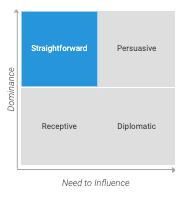
Communication Style can be summarized as the way that a person sends a message to one or many peers, verbally or otherwise. For employees, there’s an ever-growing number of ways to communicate beyond just face-to-face interaction. Understanding the way an individual tends to express their thoughts and opinions during in-person conversations, emails, video calls and more can help predict their future interactions in the workplace.
There are four styles of communication, derived from the combination of the “Dominance” dimension of personality and the “Need to Influence” dimension of motivation:
- Straightforward (Assertive, Need to Open Up to Others’ Opinions): Individuals who are Straightforward Communicators are inclined to clearly state their ideas while keeping a neutral tone and being respectful of others’ views.
- Persuasive (Assertive, Need to Sway Others’ Opinions): Individuals who are Persuasive Communicators are inclined to dominate others in interactions by openly convincing them to see things their way.
- Receptive (Compliant, Need to Open Up to Others’ Opinions): Individuals who are Receptive Communicators are inclined to speak softly in interactions, and mostly listen to others’ points of views in order to please them.
- Diplomatic (Compliant, Need to Sway Others’ Opinions): Individuals who are Diplomatic Communicators are inclined to control the course of discussions to their advantage by placing underlying messages in their spoken words.
Conflict Management
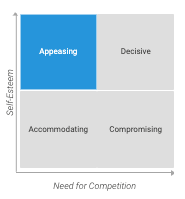
Conflict Management can be described as the way that a person tries to limit the negative aspects of a confrontation while increasing its positive impacts. Conflict doesn’t always take place in the form of direct confrontation. Being aware of the ways in which individuals will handle situations where there are differing opinions — both big and small — can help leaders facilitate as needed so that certain individuals’ voices and opinions are being heard over the individuals who might be more confident and determined to win.
There are four behavior types when it comes to conflict management, derived from the combination of the “Self-Esteem” dimension of personality and the “Need for Competition” dimension of motivation:
- Appeasing (Confident, Need to Cooperate): Individuals who are Appeasing in Conflict tend to dig into the underlying concerns and consider the views of others.
- Decisive (Confident, Need to Win): Individuals who are Decisive in Conflict tend to settle it by asserting their own solution.
- Accommodating (Modest, Need to Cooperate): Individuals who are Accommodating in Conflict put aside their own needs in order to keep the peace with others.
- Compromising (Modest, Need to Win): Individuals who are Compromising in Conflict tend to ignore or withdraw from it rather than facing it.
Team Contribution
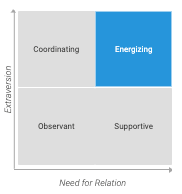
Team Contribution can be summarized as the way that an individual cooperates and works with others in a group setting in order to achieve organizational goals. This is not only useful for individuals who work in the same department or formal team, but for understanding the role a person tends to play even in the informal group projects and activities that occur in the workplace.
There are four ways individuals can approach team contribution, derived from the combination of the “Extraversion” dimension of personality and the “Need for Relation” dimension of motivation:
- Coordinating (Extroverted, Need for Privacy): Individuals who are Coordinating teammates expect efficiency, focus on goals and coordinate people together
- Energizing (Extroverted, Need to Socialize): Individuals who are Energizing teammates get excited and draw others in with enthusiasm, while showing a relatively short attention span.
- Observant (Introverted, Need for Privacy): Individuals who are Observant teammates focus on content, and are likely to ask others about their expectations regarding their role in the process.
- Supportive (Introverted, Need for Socialize): Individuals who are Supportive teammates are loyal team players, by actively listening, discussing and defending the different views of others.
The behaviors results of MyPrint help in understanding the ways in which individuals actually act or conduct themselves, especially toward others. This knowledge can be invaluable in building a more productive workplace.
In our next entry in our three-part Behaviors Uncovered series, we investigate three areas that are critical to the development of highly-effective problem solving teams — creativity, work and learning styles.
Interested in uncovering more about how behavior profiles can help you understand how someone will act in a professional setting? Discover the science behind MyPrint by clicking here.
How to Conduct a Soft Skills Interview in 4 Easy Steps

If you have been following our blog then you know how important we think soft skills are to incorporate into your daily work lives.
“Hard skills will get you the job, but soft skills will make you successful.” -Me, at least 3 times per week
However, sometimes this can seem overwhelming. Where should you, as a manager, start? In this blog article we will take a step-by-step look at how to use soft skills from the very beginning of the employee lifecycle: the interview process.
Step 1: The Job Requirements
At first glance, you might think you know what goes into a position. Maybe you have been hiring for this position for quite some time, or you have worked with individuals in this role before. Although you might think you know all of the important requirements for a role, it is still important to take the proper steps to evaluate a job description in order to make a more informed decision on what the role entails.
Once you have determined what hard skills and qualifications are necessary for a position, it is time to determine what soft skills will help someone be successful in this role. There are many ways to find this information. Here are a few of the common ones:
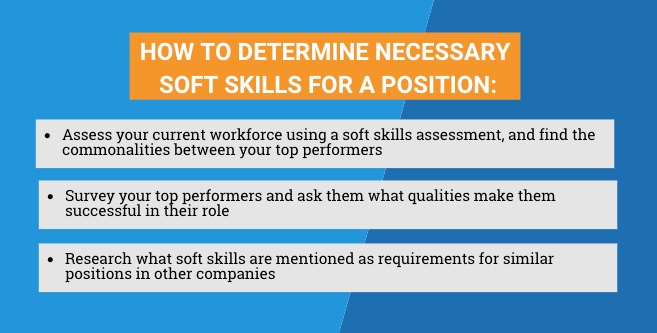
It is very important that you are using a scientifically reliable and valid method to assess your teams’ soft skills. For the purpose of this article, we recommend using the MyPrint® assessment to assess your current workforce and using some of our tools available through Talentobe Manager to determine what to look for during the interview process.
An important note here: although you are looking for commonalities among your top performers, that does not mean that you want a cookie cutter of those individuals. One of the most important things for a team’s success is having diversity among group members to help fill in skills gaps and increase creativity and innovation¹.
Step 2: Preparation
Now that you have determined what the important soft skills are for the position, you need to prepare for the interview. Having a set interview process helps to ensure that you are making more informed decisions for your company and not using personal judgments or unconscious biases when hiring. Topgrading² is one example of an interview methodology that is intended to help identify top talent, and incorporating soft skills into this methodology is seamless.
Prior to the interview starting, you will also want your candidates to complete a MyPrint® assessment (check that their results are from the past 6 months to ensure accuracy). Make sure that the hiring manager and anyone involved in the interview process have taken the time to review the candidate’s MyPrint® One Pager (soft skills summary) and are familiar with the soft skills that have been determined important for the role.
To prepare for the soft skills portion of the interview, we recommend that you have the Premium Report version of the candidate’s results handy and review their top 3 personality strengths, motivators, and behaviors (as shown on the One Pager report). Then ask yourself the following questions:
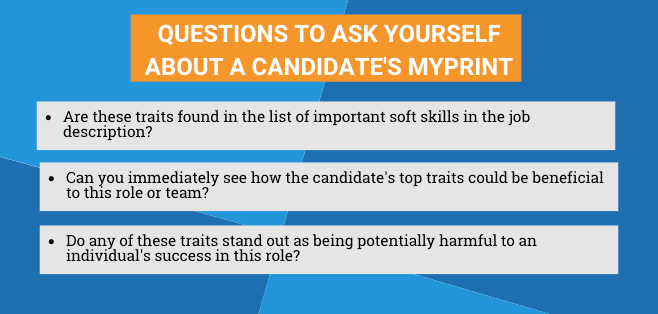
Lastly, take a look at the candidate’s behaviors. The MyPrint® Premium Report has two interview questions tailored to each behavioral style to help gain a better understanding of how that individual showcases those styles. Make a note of any behaviors that you would like to dig deeper on, and have those interview questions ready to go!
Step 3: Conducting the Interview
When conducting a soft skills interview, it is important to stay open minded. If someone’s top three MyPrint® traits aren’t the exact three that you are looking for that does not mean they are not going to be a good candidate. Instead, look at their Premium Report to see where they fall on the scale for each of those traits. Take the time to ask questions around those topics, and make sure that you are being clear about the role expectations and see if that matches what they are looking for.
Step 4: Scoring the Interview
Once the interview is completed and the candidate has left, it is not time to make a decision quite yet! Take the time to review your interview notes and apply some quantitative metrics to what you were looking at.
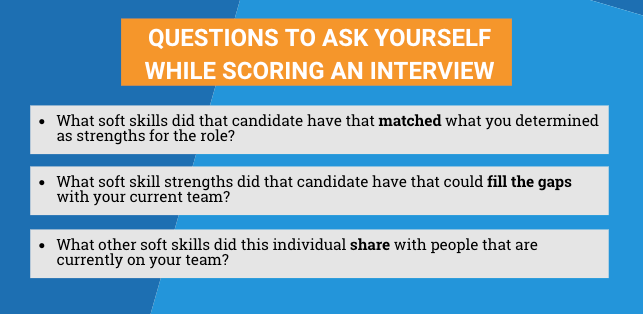
To ensure fairness between candidates, use a standardized method of scoring the interviews. Grading methods can include ranking responses or finding the difference between ideal scores and actual scores in their MyPrint® scales.
To Sum It All Up…
Using soft skills in the interview process can help you make more informed hiring decisions, and help you find candidates who will be more successful in their role. The interview process is an investment for everyone involved, so it is not something that should be done without careful evaluation and purpose.
Remember to be open-minded when it comes to soft skills; you won’t have all of the answers right away. As you gather more information over time you will learn more about what personality traits, motivations, and behavioral styles can be attributed to success in a role and sometimes, what you find might surprise you!
Want more information about soft skill interviewing, or to receive a copy of our template? Email Talentobe at customer@talentobe.com to learn more about our assessment and services!
Sources
¹https://www.managers.org.uk/knowledge-and-insights/listicle/the-five-business-benefits-of-a-diverse-team/
²https://topgrading.com/


